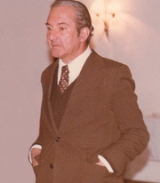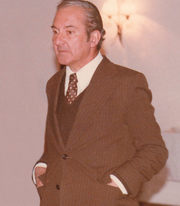
Carlos Sotomayor
Encyclopedia

Chile
Chile ,officially the Republic of Chile , is a country in South America occupying a long, narrow coastal strip between the Andes mountains to the east and the Pacific Ocean to the west. It borders Peru to the north, Bolivia to the northeast, Argentina to the east, and the Drake Passage in the far...
an painter
Painting
Painting is the practice of applying paint, pigment, color or other medium to a surface . The application of the medium is commonly applied to the base with a brush but other objects can be used. In art, the term painting describes both the act and the result of the action. However, painting is...
, born in La Serena, Chile. He is considered to be one of the principal exponents of the cubism
Cubism
Cubism was a 20th century avant-garde art movement, pioneered by Pablo Picasso and Georges Braque, that revolutionized European painting and sculpture, and inspired related movements in music, literature and architecture...
from South America
South America
South America is a continent situated in the Western Hemisphere, mostly in the Southern Hemisphere, with a relatively small portion in the Northern Hemisphere. The continent is also considered a subcontinent of the Americas. It is bordered on the west by the Pacific Ocean and on the north and east...
.
Early years
His father, Carlos Sotomayor Caceres was a Civil Engineer who worked for the Chilean Railway Company (Empresa de los Ferrocarriles del EstadoEmpresa de los Ferrocarriles del Estado
Empresa de los Ferrocarriles del Estado is the national railway of Chile.The track gauge is Indian gauge in the south and metre gauge in the north.-History:...
), married to Julia Roman Morales. They had 5 children: Carlos, Julio (poet), Lucia, Ines (agronomist) and Elena.
In his teenage years Carlos Sotomayor met the painter and sculptor Laura Rodig, who had just come back from Europe and worked with her, putting up an exhibition together with Pedro Olmos.
He studied at the Instituto Nacional
Instituto Nacional
Instituto Nacional , founded on August 10, 1813 by the Chilean patriot José Miguel Carrera , officially Liceo Ex A-0 - Instituto Nacional General José Miguel Carrera, is Chile's oldest and most prestigious school...
in Santiago
Santiago, Chile
Santiago , also known as Santiago de Chile, is the capital and largest city of Chile, and the center of its largest conurbation . It is located in the country's central valley, at an elevation of above mean sea level...
and in 1931 he studied at the School of Architecture of the Universidad de Chile. However, in 1932 he opted to study at the Fine Arts College of the same university instead. Some of his teachers were Jorge Caballero, Herman Gazmuri and Augusto Eguiluz.
Work

Vicente Huidobro
Vicente García-Huidobro Fernández was a Chilean poet born to an aristocratic family. He was an exponent of the artistic movement called Creacionismo , which held that a poet should bring life to the things he or she writes about, rather than just describe them.Huidobro was born into a wealthy...
, with whom Carlos Sotomayor shared a close friendship.
In 1934 Sotomayor joined the Grupo Decembrista, together with Maria Valencia, Gabriela Rivanedeira, Jaime Dvar and Waldo Parraguez. This group of neocubist artists was led by Vicente Huidobro. Two years later, Carlos Sotomayor married Franka Serka Jurac, fellow student at the Fine Arts College.
In 1937 he joined the Grupo Rectangulo de Arte Moderno, encouraged by the artist Vergara Grez. He exhibited at the Alianza de Intelectuales de Chile together with Maria Valencia, Waldo Parraguez and Haroldo Donoso.
In August 1944 he exhibited 20 paintings at the Sala del Ministerio de Educacion. In the catalogue there were articles and poems by the poets Eduardo Anguita and Julio Molina. The critic Antonio Romera wrote a very complimentary review in the press.
In 1946 Sotomayor exhibited several oil paintings and drawings at the Sala del Ministerio de Educacion. The writer Andres Sabella wrote an article about it.
In December 1952 Sotomayor exhibited at the Sala Pro Arte and in 1953 he took part in the Primer Salon de Primavera de la Casa de la Cultura de Nunoa, together with 50 other artists: Jose Balmes, Sergio Montecinos, Raul Santelices and Jose Venturelli among them.
In 1955 he started working at the Chilean Railway Company (EFE
EFE
EFE is a Spanish news agency created in 1939 by Spain's former minister of the press and propaganda Ramón Serrano Súñer and Manuel Aznar Zubigaray....
) as a draughtsman in the Department of Vias & Obras.
In 1960 Sotomayor took part in La Segunta Feria de Artes Plasticas (Parque Forestal) organised by the Museo de Arte Moderno. Sotomayor won second prize.
Sotomayor exhibited his works at the Exposicion de Pintura Chilena Nueva in March 1962, organised and sponsored by Empresa Esso Oil Co. Nemesio Antunez and Jose Balmes also participated.
In November 1966 Sotomayor exhibited his oil paintings at the Sala del Instituto de Artes Plasticas de la Universidad de Chile.
His last exhibition while he was alive, took place in 1979 at the Galeria Eco, where there were 30 of his paintings, among them: The painter and his models, Rape 1 and Landscapes of Cartagena. The art critic Jose Maria Palacios praised Sotomayor’s works in the press.
In 1973 Sotomayor retired from the F.F. C.C. del E. and devoted himself entirely to his paintings until his death.
In 1984 he travelled to Europe
Europe
Europe is, by convention, one of the world's seven continents. Comprising the westernmost peninsula of Eurasia, Europe is generally 'divided' from Asia to its east by the watershed divides of the Ural and Caucasus Mountains, the Ural River, the Caspian and Black Seas, and the waterways connecting...
where he visited museums of modern art in Paris
Paris
Paris is the capital and largest city in France, situated on the river Seine, in northern France, at the heart of the Île-de-France region...
, London
London
London is the capital city of :England and the :United Kingdom, the largest metropolitan area in the United Kingdom, and the largest urban zone in the European Union by most measures. Located on the River Thames, London has been a major settlement for two millennia, its history going back to its...
, Birmingham
Birmingham
Birmingham is a city and metropolitan borough in the West Midlands of England. It is the most populous British city outside the capital London, with a population of 1,036,900 , and lies at the heart of the West Midlands conurbation, the second most populous urban area in the United Kingdom with a...
and Rome
Rome
Rome is the capital of Italy and the country's largest and most populated city and comune, with over 2.7 million residents in . The city is located in the central-western portion of the Italian Peninsula, on the Tiber River within the Lazio region of Italy.Rome's history spans two and a half...
.
In 1988 he suffered a heart attack
Myocardial infarction
Myocardial infarction or acute myocardial infarction , commonly known as a heart attack, results from the interruption of blood supply to a part of the heart, causing heart cells to die...
from which he did not recover and died on 17 April.
In the year 2004, there was realized an exhibition of his paintings in the Cultural Corporation of Las Condes
Las Condes
Las Condes is a commune of Chile located in Santiago Province, Santiago Metropolitan Region. The area is inhabited primarily by upper-mid to high income families...
, so called "Carlos Sotomayor: A modern classic"
A Unique Figure in Chilean Painting (by J. Palacios)
A retired employee of the Chilean Railways, quiet, with a distant air, most people would not suspect that he is an artist, particularly a modern one. However, this unassuming artist inspired the critic Antonio Romera to write about him: 'Perhaps, in the entire history of Chilean painting, there isn't a clearer example of dedication to artistic creativity for its own sake.' And it would be difficult to find a more fitting observation.Even as a teenager he displayed an innovative vision. At 14, he took part in a poster competition for the Spring Festival, encouraged by his father.
An excellent draughtsman, with a line capable of expressing both the graceful and the vigorous in the classical tradition, Carlos Sotomayor could have worked entirely figuratively, an approach which would have brought him instant commercial success. With his mastery of line, he could also have diversified into printmaking, but his instinct was for painting. As a result, in 1934 he joined the Grupo Decembrista, a neocubist group led by the poet Vicente Huidobro, one of his most fervent admirers, who revealed his enthusiasm for Sotomayor's work in the magazine PRO published in the same year.
Curiously, it was the writers of the avant-garde who were the first to recognise Sotomayor's genius. E. Anguita, who won the 1988 Writer of the Year Award, Julio Molina and Guillermo Atías were among his greatest apologists, praising him as a painter who did not confine his work to the replication of reality, or to conventional romanticism. Supported by the solid foundation of his drawings, Sotomayor alters reality in order to render it more real, in the quest for more sensitive communication through highly personal, expressive forms. He is both violent and tender at the same time.
He remains an enigma, a solitary figure, praised by a few and still unknown to the majority. He doesn't win official accolades, nor do they hold any interest for him. Quiet, retiring, conversing only with his friends, the artist is not afraid of confronting his own solutions. Sensitive to current events, the initial figuration suddenly emerges in his work, but not as a final phase of his expression, only as the rebelliousness of a pure spirit. It is for this reason that, although efforts have been made to pigeonhole it, Sotomayor's work admits no labels. Picasso may be in the background, but it is because he admires in him, above all, his creative independence. The poet E. Anguita goes as far as saying that Sotomayor's painting is like the image of a "restless idea", a definition which the critic Romera elaborates on, underlying it as "a certain restlessness or agitation of the spirit.'.

